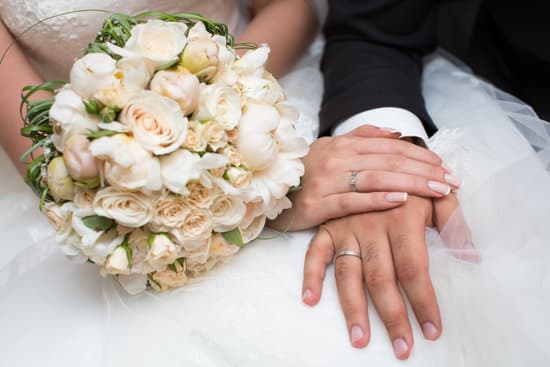How do you exchange rings at a wedding? The exchange of wedding rings is a significant and symbolic tradition in many cultures around the world. This longstanding custom holds deep meaning, representing love, commitment, and the eternal bond between two people. Dating back centuries, the act of exchanging rings during a wedding ceremony has evolved into an essential ritual that marks the beginning of a new chapter in a couple’s life together.
The tradition of exchanging rings at a wedding dates back to ancient Egyptian times, where the circular shape of the ring was believed to symbolize eternity and never-ending love. Over time, this practice has become deeply ingrained in various cultures and continues to be an integral part of modern wedding ceremonies. Today, couples exchange rings as a visible sign of their commitment to one another and as a representation of the value they place on their relationship.
In this article, we will explore the significance of exchanging rings at a wedding and delve into both traditional and modern variations of this timeless ceremony. Additionally, we will discuss alternative ways for couples to exchange rings, etiquette surrounding who should exchange rings first, tips for a smooth ring exchange, meaningful vows or promises to accompany the ring exchange, as well as non-traditional methods for exchanging rings for those seeking a unique touch to their wedding ceremony.
The Symbolism of the Wedding Rings
The exchange of wedding rings is a traditional and meaningful aspect of the wedding ceremony. The symbolism behind these rings holds great significance for the couple, reflecting their commitment and love for each other. The circular shape of the rings represents eternity and the never-ending nature of the couple’s love for each other. This unbroken circle symbolizes the everlasting bond that they are forming through marriage.
In addition to the circular shape, the precious metal and gemstones used in the rings also carry symbolic meaning. The metal, often gold or platinum, reflects the enduring value and strength of the relationship. Meanwhile, gemstones such as diamonds can represent the purity and beauty of the love shared between partners. Couples may choose specific stones based on personal preference or cultural significance, further imbuing their rings with meaning.
Personalized Rings
Many couples nowadays take a personalized approach to their wedding rings, choosing unique designs that reflect their individual personalities and their relationship. Some opt for custom engravings on their bands or select non-traditional materials or styles for a one-of-a-kind touch.
Cultural Traditions
It’s also important to note that different cultures have their own traditions surrounding wedding rings and their symbolism. For example, in some cultures, there may be specific customs regarding how the ring is worn or exchanged during a ceremony. Understanding these cultural nuances can add depth and richness to the symbolism of exchanging rings at a wedding.
Ultimately, the symbolism of wedding rings goes beyond just being beautiful pieces of jewelry; they represent an enduring commitment between two people embarking on a lifelong journey together. The personal touches added by couples make these symbols even more meaningful, creating lasting reminders of their love and partnership.
Traditional Ring Exchange Ceremony
The traditional ring exchange ceremony is a significant and emotional part of many wedding ceremonies. This ritual symbolizes the couple’s commitment to each other and their promise to love and cherish one another for eternity. The tradition of exchanging rings dates back to ancient Egypt when rings were believed to symbolize an unending cycle, much like the unbroken circle of the ring itself.
During a traditional ring exchange ceremony, the groom usually goes first, placing the bride’s wedding band on her finger as a symbol of his everlasting love and commitment. The exchange is then completed when the bride places the groom’s wedding band on his finger. However, in modern ceremonies, some couples choose to have both partners place the rings on each other’s fingers simultaneously as a mutual expression of their love and commitment.
In different cultures around the world, there are variations in how the ring exchange takes place. For example, in some traditions, such as those in Eastern Europe and South America, the couple may wear their engagement rings on their right hands, which are then transferred to their left hands during the wedding ceremony.
Regardless of cultural differences, the act of exchanging rings remains a powerful symbol of unity and devotion between two individuals who are embarking on a lifelong journey together. Regardless of how you exchange rings at a wedding, this moment is sure to be memorable for both you and your partner as you embark on your new life together.
Modern Trends in Exchanging Rings
The exchange of wedding rings dates back centuries, symbolizing the eternal love and commitment between two individuals. While the traditional ring exchange ceremony remains a timeless and beloved tradition, modern couples have begun to embrace a variety of alternative ways to exchange rings at their weddings. These unique methods add a personalized touch to the ceremony and reflect the individuality of each couple.
Here are some modern trends in exchanging wedding rings:
1. Ring Warming: In this alternative ring exchange ceremony, the couple’s wedding rings are passed from guest to guest, allowing them to “warm” or bless the rings with their love and well wishes for the couple’s marriage. This symbolic act involves family and friends in the ceremony, creating a sense of community and support for the newlyweds.
2. Ring Box Alternatives: Some couples opt for unique ring boxes or pouches that hold sentimental value or reflect their interests and personalities. Whether it’s a vintage trinket box or a handmade pouch, using non-traditional containers for the wedding bands adds an unexpected twist to the ring exchange.
3. Unity Ceremonies: Instead of a traditional ring exchange, some couples choose to incorporate unity ceremonies into their wedding rituals. For example, they can participate in a sand blending ceremony or mix two different colored liquids together to symbolize their union before exchanging rings as a public declaration of commitment.
The trend of modern alternatives for exchanging rings at weddings reflects how today’s couples are redefining traditions to align with their personal values and beliefs.
Who Should Exchange Rings First?
Traditionally, the groom will place the ring on the bride’s finger first during the wedding ceremony. This gesture is a symbol of his commitment to take care of her, and keep her safe and secure throughout their lives together. However, many contemporary couples choose to exchange rings at the same time, as a sign of unity and equality in their relationship. Some even opt for a more unique approach by exchanging each other’s rings simultaneously.
In some cultures, the tradition is for both partners to place the ring on each other’s fingers at the same time as a commitment to equality in their marriage. Other cultures may have different customs such as having family members or a officiant bless and present the rings before they are exchanged. These variations add an element of diversity and cultural significance to this age-old tradition.
Another increasingly popular practice sees that both partners hold their own rings during part of the ceremony, often saying personally written vows, only exchanging them after having declared their intentions for one another. This modern spin on tradition allows both partners to take an active role in professing their love and desire for commitment before officially sealing it with a ring exchange.
Ultimately, regardless of who exchanges rings first, it is important that it reflects what feels right for each individual couple. Whether it be following age-old customs or creating new ones based on personal beliefs and values, what matters most is that the exchange represents genuine sentiments of love and commitment between two people embarking upon a lifelong journey together.
Tips for a Smooth Ring Exchange
Exchanging rings at a wedding is a significant and meaningful part of the ceremony, symbolizing the couple’s commitment and everlasting love for each other. The tradition of exchanging rings dates back centuries, with the circular shape representing eternity and the precious metal and gemstones symbolizing the value of the relationship.
As such an important aspect of the wedding ceremony, it’s essential for couples to ensure that the ring exchange goes smoothly and is memorable for all the right reasons.
To have a smooth ring exchange, it’s crucial for couples to communicate with their officiant or wedding coordinator about the logistics of the ceremony. This includes determining who will be responsible for holding onto the rings until they are needed, as well as establishing where and how the rings will be presented during the ceremony. Additionally, couples should practice putting each other’s rings on beforehand to avoid fumbling or struggling during the actual exchange.
Another tip for a smooth ring exchange is to choose rings that fit comfortably. Ill-fitting rings can cause unnecessary stress during the ceremony, so it’s important to ensure that both partners’ rings are sized correctly ahead of time. Furthermore, couples should consider having designated “ring bearers” if they have young children or beloved pets who can participate in bringing the rings down the aisle.
Lastly, it’s wise for couples to designate close family members or friends as “emergency contacts” in case something goes wrong with their rings on their wedding day. Having a trusted individual on standby with spare rings or knowing how to quickly solve any issues that may arise can offer peace of mind and alleviate any potential stress surrounding the ring exchange at one’s wedding.
By following these tips and preparing accordingly, couples can ensure a smooth and seamless ring exchange ceremony on their special day.
Ring Exchange Vows
The ring exchange vows are an essential part of the wedding ceremony, as they symbolize the couple’s commitment and promises to each other. These vows are typically spoken by the bride and groom as they exchange rings, adding a deeply meaningful and personal aspect to the tradition.
Meaningful Vows for Ring Exchange
During the ring exchange, couples often choose to recite traditional wedding vows or opt for more personalized words that truly reflect their relationship. Personalized vows can include promises of love, support, and loyalty, as well as unique anecdotes or references that hold special meaning for the couple. Including specific details about what the ring represents or how it signifies their everlasting bond can add depth to the exchange.
Incorporating Personalized Vows
To incorporate personalized vows into the ring exchange, couples should take time to carefully consider what they want to convey to their partner. They may choose to write their own vows or seek inspiration from poetry, literature, or even shared experiences. Additionally, some couples opt to consult with their officiant or a wedding planner for guidance on crafting meaningful and heartfelt vows.
Alternate Ways to Exchange Rings
For couples looking to put a unique and personalized twist on their wedding ceremony, there are a variety of alternative ways to exchange rings. One creative option is to have the rings passed among the guests before being exchanged, symbolizing the love and support of family and friends. Another idea is a ring warming ceremony, where the rings are passed from guest to guest, allowing each person to imbue them with their blessings and well-wishes for the couple.
Some couples choose a unity ceremony in which they combine or blend different materials – such as sand, water, or colored liquids – into a single container, symbolizing their union. This can be accompanied by an exchange of matching bracelets or other temporary symbols of commitment that will be replaced by the rings during the formal part of the ceremony.
For those who want to incorporate their cultural heritage into the ring exchange ceremony, they may choose to follow traditional practices from their background. For example, in some cultures, coins or other symbolic items are exchanged along with or instead of rings.
Couples should take into consideration what is most meaningful and representative of their relationship when choosing an alternative way to exchange rings at their wedding. Whether it’s incorporating cultural traditions or creating something entirely unique, there are countless ways for couples to make this special moment truly their own.
Conclusion
In conclusion, the exchange of rings at a wedding holds immense significance as it symbolizes the eternal and never-ending love between two individuals. The tradition of exchanging rings dates back centuries and has evolved to encompass various cultural variations and modern trends. Whether through a traditional or personalized ring exchange ceremony, the act of exchanging wedding rings remains a deeply emotional and symbolic moment for couples.
The circular shape of the wedding ring represents eternity and the unending commitment between partners, while the precious metal and gemstones symbolize the value and significance of the relationship. Additionally, the exchange of vows during this ceremony further solidifies the promises made by the couple.
From traditional methods to non-traditional and creative approaches, there are countless ways for couples to exchange rings at their wedding. Regardless of how a couple chooses to exchange their rings, it is important that the ceremony reflects their unique bond and serves as a lasting memory for both themselves and their guests. Ultimately, the ring exchange at a wedding is a beautiful celebration of love, commitment, and unity.
Frequently Asked Questions
Do You Say I Do Before Exchanging Rings?
In many traditional wedding ceremonies, the “I do” is typically said before exchanging rings. This verbal affirmation of commitment and consent to the marriage comes before the physical exchange of rings between the couple.
What Is the Tradition of Exchanging Rings at a Wedding?
The tradition of exchanging rings at a wedding symbolizes the unending love and commitment between the couple. The circular shape of the ring represents eternity and the unbroken bond of marriage. This exchange is often accompanied by vows or promises to signify the couple’s devotion to one another.
Do You Wear Your Engagement Ring Down the Aisle?
It is common for individuals to wear their engagement ring down the aisle alongside their wedding ring. The engagement ring is worn on the fourth finger of the left hand, followed by the wedding band during the ceremony. Some choose to continue wearing both rings together while others opt to wear just their wedding band after getting married.

I have been involved in marriages for over 20 years helping couples and singles understand more about them.





